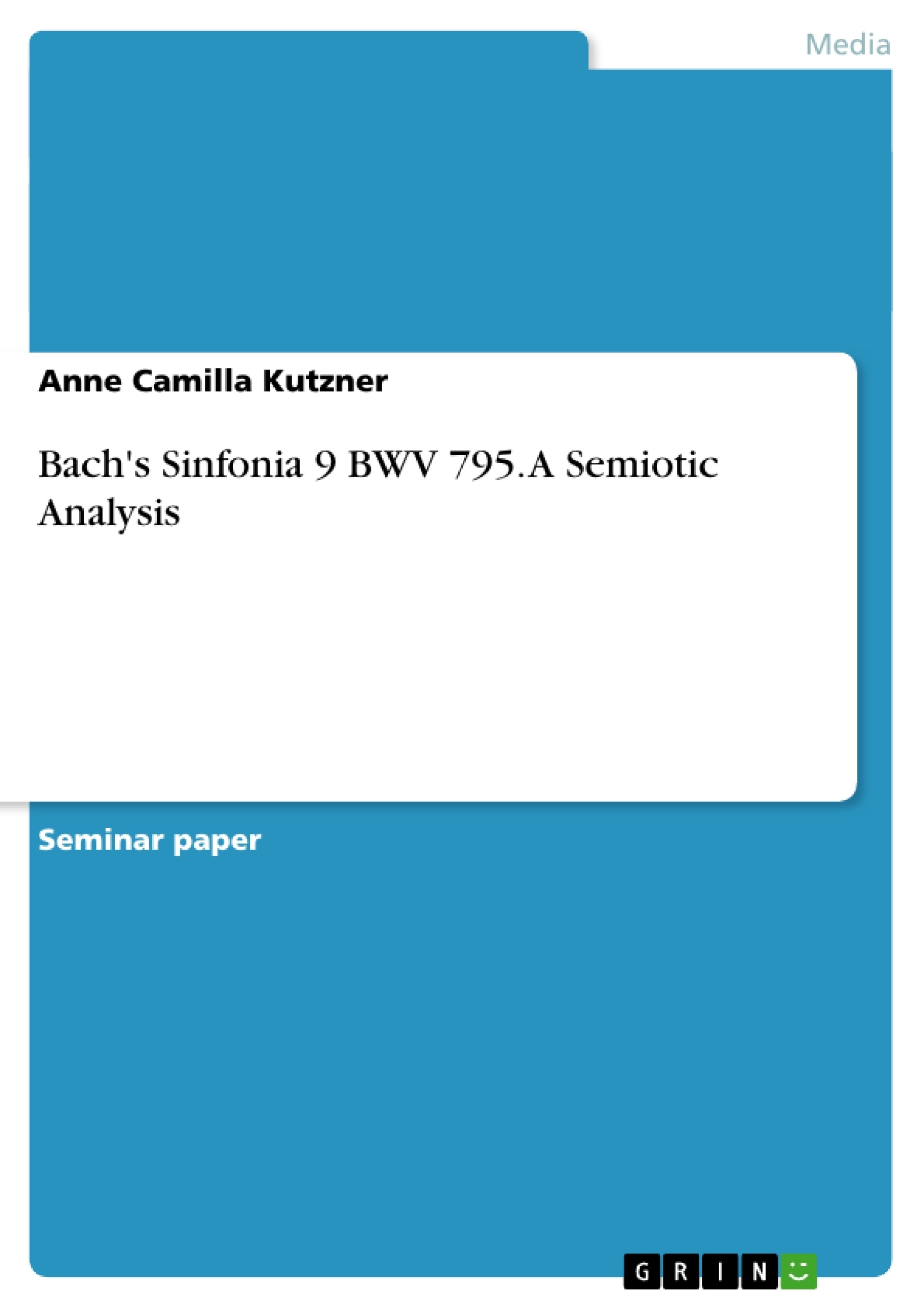Introduction and Overview
The idea of this paper is an analysis of Bach’s Sinfonia 9 in f minor, BWV 795, first with the tools of structural analysis I learned in counterpoint and harmony classes, then with a semiotic approach. The project is to try to determine whether semiotic analysis can help us in understanding highly “abstract”, non-programmatic instrumental music. I have chosen this piece for two reasons. The first is simply experience. I have done analyses of it before, in a counterpoint class. I remember the sessions about this piece being hard work, but then there was a moment of understanding and suddenly it all seemed so simple. (A look at the harmonic issues will show it is still very complicated.) The second reason is the seemingly abstract nature of the piece. In spite of this abstraction, I do get emotionally involved when listening to this piece, I cannot ignore the emotion of sadness and suffering. So the semiotic part of this analysis is about the referential elements under the abstract surface, about the expressive content of an instrumental, non-programmatic piece. The goal is to show one of the possible ways in which meaning is attributed to music: in this case, by conventionalized signifiers.
Contents
Introduction and Overview
Structural Analysis
“Ein harmonisches Vexierspiel” (Hindemith)
Counterpoint Issues
Harmonic Interpunctions and Formal Issues
Semiotic Analysis
A semiotic approach: Signifiers in BWV 795
Raymond Monelles Analysis of BWV 886
The subjects and their possible interpretation
Subject
Countersubject
Second Countersubject
What is different in BWV 795?
Speculations
Literature
Introduction and Overview
The idea of this paper is an analysis of Bach’s Sinfonia 9 in f minor, BWV 795, first with the tools of structural analysis I learned in counterpoint and harmony classes, then with a semiotic approach. The project is to try to determine whether semiotic analysis can help us in understanding highly “abstract”, non-programmatic instrumental music.
I have chosen this piece for two reasons. The first is simply experience. I have done analyses of it before, in a counterpoint class. I remember the sessions about this piece being hard work, but then there was a moment of understanding and suddenly it all seemed so simple. (A look at the harmonic issues will show it is still very complicated.)
The second reason is the seemingly abstract nature of the piece. In spite of this abstraction, I do get emotionally involved when listening to this piece, I cannot ignore the emotion of sadness and suffering. So the semiotic part of this analysis is about the referential elements under the abstract surface, about the expressive content of an instrumental, non-programmatic piece. The goal is to show one of the possible ways in which meaning is attributed to music: in this case, by conventionalized signifiers.
Structural Analysis
“Ein harmonisches Vexierspiel” (Hindemith)
When listening to the first two measures, we tend to hear the second note of each group of three notes as a suspension note. Like this:
illustration not visible in this excerpt
(the heard – or expected - dissonances are marked red).
But with a look at the score, we will see that in the first measure the heard dissonances are in fact consonant and what appears to be the resolution is in fact the anticipation note:
illustration not visible in this excerpt
Every one of these dissonances is treated according to the rules of counterpoint.
According to the analysis of Paul Hindemith, the listener is inclined to follow the melodic line and hear the second eighth of each three-note-group (of the upper voice) as a suspension note and the third as a resolution, while (as we have seen) the real suspension lies on the last eighth of each group. But in the further course of the piece, it becomes still more complicated: In the third measure, the expected relations are actually encountered: third and seventh eighth are actually dissonant. In the seventh measure, expected and actual dissonances fall apart again, and this alternation continues throughout the whole piece.[1]
[...]
[1] Paul Hindemith, Unterweisung im Tonsatz, Mainz 1937, p.245
- Quote paper
- Anne Camilla Kutzner (Author), 2004, Bach's Sinfonia 9 BWV 795. A Semiotic Analysis, Munich, GRIN Verlag, https://www.grin.com/document/42028
-

-

-

-
Upload your own papers! Earn money and win an iPhone X. -

-
Upload your own papers! Earn money and win an iPhone X. -

-
Upload your own papers! Earn money and win an iPhone X. -

-
Upload your own papers! Earn money and win an iPhone X. -

-
Upload your own papers! Earn money and win an iPhone X.

